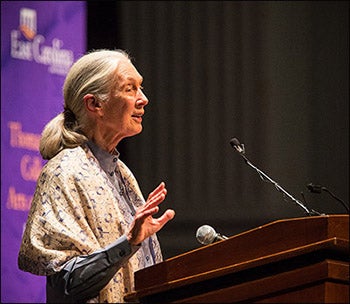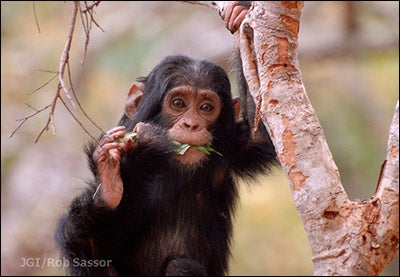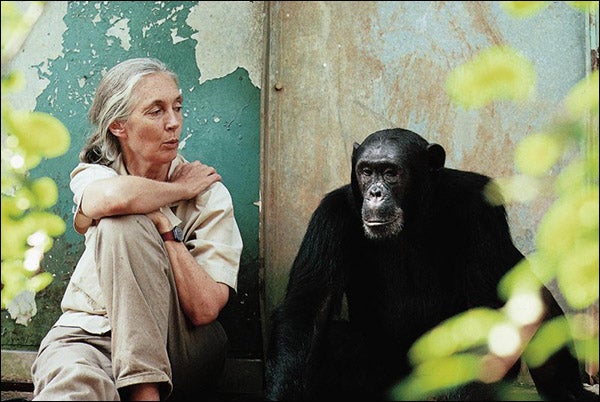‘MEMORABLE AND MEANINGFUL’
Anthropologist Jane Goodall shares her passions at ECU
Jane Goodall barked a series of chimpanzee cries that sounded startlingly real.
Then, her face melted into a smile. “Hello,” she said in a soft, lyrical voice. “This is me.”
Goodall held court over a packed Wright Auditorium Oct. 1 as part of the Thomas Harriot College of Arts and Sciences’ 2013-14 Voyages of Discovery Lecture Series. She was met with a standing ovation shortly before she began the sold-out Premier Lecture, “Sowing the Seeds of Hope.” The event was so popular that it was also simulcast in Bate Building and Mendenhall Student Center to accommodate those on campus and in the community who did not get tickets.
“East Carolina had an evening for the ages last night,” said Dr. John Tucker, professor of history and university historian, who spearheads the lecture series, “one that joins earlier evenings with Helen Keller, Amelia Earhart, Eleanor Roosevelt and Louise Leakey in a growing tradition of wisdom and grace that surely enriches our campus, community, and region.”

Goodall speaks a capacity crowd at Wright Auditorium. (Photo by Cliff Hollis)
Goodall is a world-renowned anthropologist whose discoveries made while studying chimpanzees in what is now Tanzania changed the way scientists consider the relationship between people and non-human primates.
At the dawn of her fieldwork in 1960 at Gombe Stream, Goodall observed chimpanzees using grass and twigs to dig termites from a mound and realized that humans were not the only animals to use and make tools to complete tasks. She also was a pioneer for women in anthropology as one of the first to study in the field.
Goodall’s love of science began when she was a child; she read as many books as she could get her hands on. One favorite, she said, stands out in her mind: Tarzan of the Apes.
“I fell in love with that glorious lord of the jungle,” Goodall said during the lecture. “What did he do? He married the wrong flippin’ Jane.”
And the crowd roared.
‘The closest thing to a celebrity’
Earlier in the day, a knot of excited anthropology majors stood outside a classroom in Bate Building. Goodall had agreed to participate in a question-and-answer session with a group of about 18 students before she prepared for the evening lecture.
When the classroom door opened, the nervous chatter trailed off to an almost reverent silence. They filed in and were soon face to face with Goodall, who put them at ease with advice and answers to questions ranging in topic from primates in biomedical research labs to her Roots and Shoots international conservation organization for youth.
Others asked how to begin a path of success that mirrors Goodall’s.
“I’ll tell you what my mother told me,” she said. “If you want something, you have to work hard.”
Students in the Anthropology Student Organization (ASO) worked hard prior to Goodall’s visit to raise money for the Jane Goodall Institute, which Goodall founded in 1977 to address preservation of the environment and all living things and to continue the Gombe research.
The institute is a global leader in the effort to protect chimpanzees and their habitats and is recognized for innovative, community-centered conservation and development programs in Africa and beyond.
“Anthropology students had an awesome and unforgettable discussion with Dr. Goodall that will inspire them for decades to come,” Tucker said.
“Their time with Dr. Goodall will likely be among the most memorable and meaningful experiences they have at ECU. The Harriot College of Arts and Sciences and its partners—Academic Affairs, Health Sciences, and Research and Graduate Studies—have served our students exceptionally well in making this possible.”
The students organized a bake sale that featured cupcakes decorated like monkey faces, which turned out to be a hit. Sales surpassed the students’ expectations, and they were able to present Goodall with a $1,000 check at the session. Sophomore Laura Redman and sophomore Heather Batchelder, vice president of the ASO, made the presentation.
“We’re a small organization, but we really wanted to give something back to her for coming here,” Batchelder said.
Redman added, “Jane Goodall is the closest thing to a celebrity in our profession.”
After the meeting, some students reflected on their impressions of Goodall. “She’s feisty but yet so humble,” said junior Angela Krider. “She just has a passionate aura.”
Preserving animals and environment
That passion began with a fascination with life. During the evening lecture, Goodall told vignettes of her childhood that involved observing animals and their behavior. “It was the making of a little scientist,” she said. Coupled with a staunch belief that she could accomplish whatever she set out to do, Goodall began to make her way toward some of the most ground-breaking field research known today.
“It was the life I had dreamed of as a child,” she said.
When she first got the chance to visit Africa and begin her observations, she said, “I felt like it was just for me; I felt like I was coming home.”

A baby chimpanzee at Gombe National Park, site of Jane Goodall’s famous chimpanzee research, contemplates the photographer. (Photo by Rob Sassor, courtesy of the Jane Goodall Institute)
Day after day, she took note of how groups of chimpanzees traveled together and gathered food. She soon came across the chimpanzee digging for termites, when she made the discovery that they use tools.
What she saw is considered one of the most significant findings in primatology because it changed previous comparisons between humans and non-human primates. After that breakthrough, Goodall, who some dismissed as the “National Geographic cover girl,” said she stopped worrying about making her mark on the field and instead began to study chimpanzees’ life history and how it all fit together.
She produced research from the Gombe Stream Research Center that is still scrutinized by scientists and students today.
“We’ve now been studying chimpanzees year after year, for over 50 years,” she said, “and we’re still finding so much we don’t know, still learning new things.”
While at Gombe, Goodall realized that surrounding villages were suffering because of environmental depletion. “It was so shocking to me,” she said.
She felt a calling to leave the study of the chimpanzees and focus on conservation and the development of environmentally sustainable projects through which villagers—especially women—could earn a living while helping heal the surrounding habitat. That was the beginning of the Jane Goodall Institute.
Goodall’s honors include the French Legion of Honor, the Medal of Tanzania and Japan’s prestigious Kyoto Prize. In 2002, she was appointed to serve as a United Nations Messenger of Peace and in 2003 she was named a Dame of the British Empire.
It all began with a child who had big dreams.
“I could do anything I wanted to do,” Goodall said.
‘There’s a real world out there’
After the lecture, Chancellor Steve Ballard hosted a question-and-answer session to give the audience a chance to delve deeper into Goodall’s thoughts.
“We’ve had a lot of people to come who are important in their fields,” said Dr. Linda Wolfe, professor emeritus of anthropology, “so students can see there’s a real world out there with real researchers.”
Goodall in particular is so important, she said, because she not only made the discoveries she did, but also proved that women could be successful in what was then a male-dominated area of study. Her success made it easier for other women to conduct anthropological field work.
Wolfe said Goodall’s visit backs up ECU’s reputation for dedication to discovery, reflected through the Voyages of Discovery Lecture Series. “It says a lot about ECU standing as a research institution,” she said, “that there’s a campus and community interested in research and that there are donors willing to support it.”
The sell-out crowd was thrilled with Goodall’s informative speech punctuated with witty one-liners.
“I’m more than pleased,” said junior anthropology major Haley Drabek.
“I couldn’t ask for a better way to spend my evening.”
The Voyages of Discovery Lecture Series is made possible through contributions from Harriot College’s Dean’s Advancement Council, various university organizations and many friends and supporters. For additional information, contact Dr. John A. Tucker, director of the lecture series, at 252-328-1028 or tuckerjo@ecu.edu, or visit the series’ website at http://www.ecu.edu/voyages/. For more information on Goodall, visit www.janegoodall.org.

Dr. Jane Goodall with Gombe chimpanzee Freud. (Photo by Michael Neugebaur, Courtesy of Jane Goodall Institute)